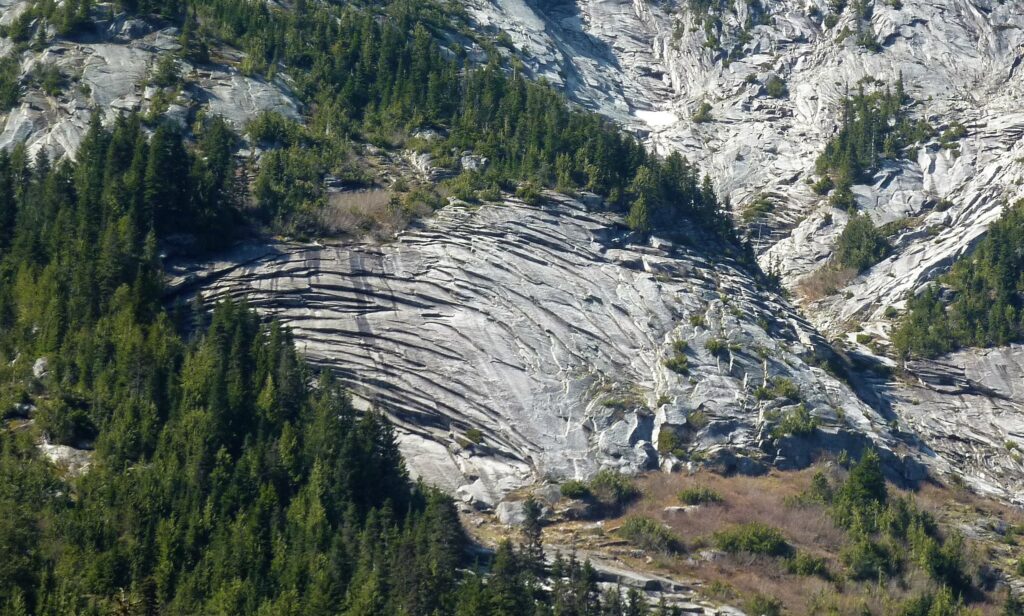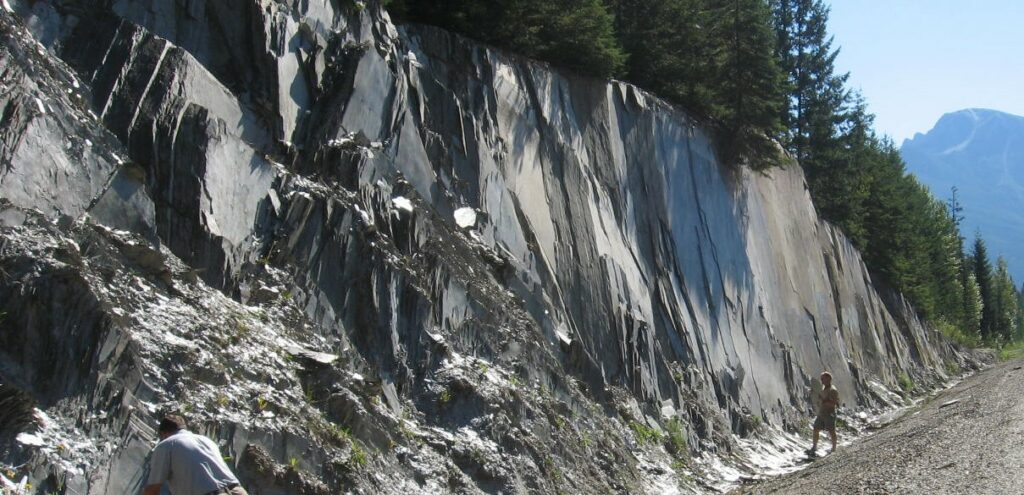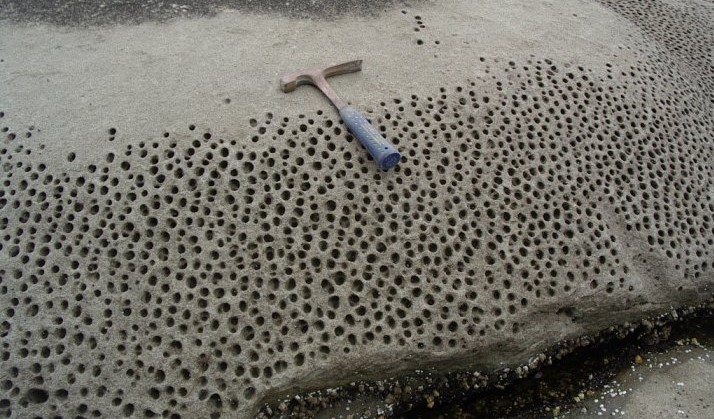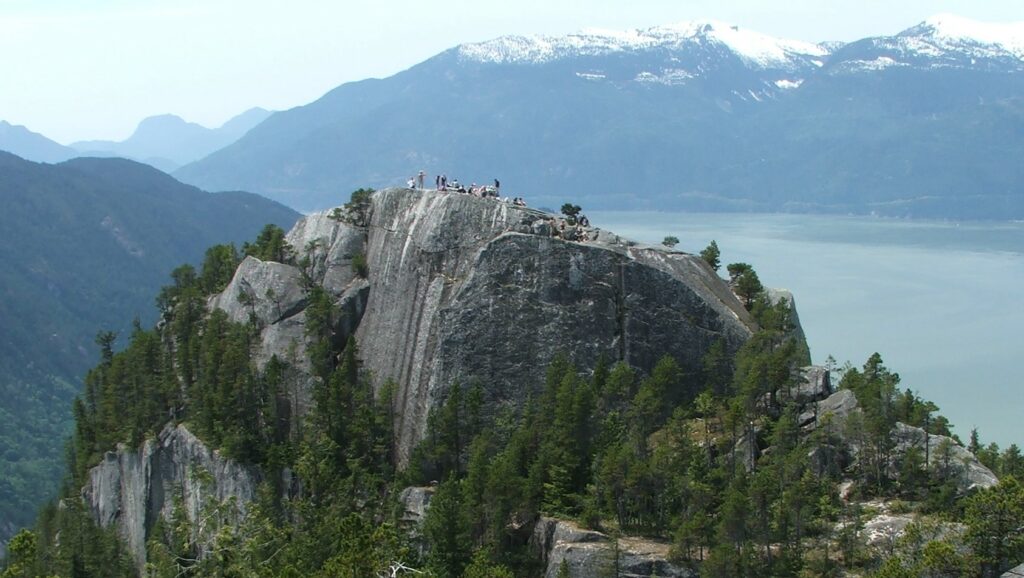10.1 Mechanical Weathering
Intrusive igneous rocks form at depths of several hundreds of metres to several tens of kilometres. Sediments are turned into sedimentary rocks only when they are buried by other sediments to depths in excess of several hundreds of metres and up to several kilometres. Most metamorphic rocks are formed at depths of kilometres to tens of kilometres. Weathering cannot even begin until these rocks are uplifted through various processes of mountain building—most of which are related to plate tectonics—and the overlying material has been eroded away and the rock is exposed as outcrop.[1]
The important agents of mechanical weathering are as follows:
- the decrease in pressure that results from removal of overlying rock,
- erosional forces related to gravity, water and wind,
- freezing and thawing of water within cracks in the rock,
- formation of salt crystals within pores in the rock, and
- plant roots and burrowing animals.
When a mass of rock is exposed by weathering and by removal of the overlying rock there is a decrease in the confining pressure on the rock, and the rock expands. This unloading promotes cracking of the rock, known as exfoliation, as shown in granitic rock on Figure 10.1.1.

Granitic rock tends to exfoliate parallel to the exposed surface because the rock is typically homogenous and it may not have pre-determined planes along which to fracture. Sedimentary and metamorphic rocks, on the other hand tend to exfoliate along predetermined planes (Figure 10.1.2).


Frost wedging is the process by which the water seeps into cracks in a rock, expands on freezing, and thus enlarges the cracks (Figure 10.1.3). The effectiveness of frost wedging is related to the frequency of freezing and thawing. Frost wedging is most effective in a climate where there are many days each year with temperatures close to freezing, so that it might freeze overnight and then thaw in the day. In warm areas where freezing is infrequent, in very cold areas where thawing is infrequent, or in very dry areas, where there is little water to seep into cracks, the role of frost wedging is limited.
A common feature in areas of effective frost wedging is a talus slope, a fan-shaped deposit of fragments removed by frost wedging (and other mechanical weathering) from the steep rocky slopes above (Figure 10.1.4).

A related process, frost heaving, takes place within unconsolidated materials on gentle slopes. In this case water in the soil freezes and expands pushing the overlying material up. Frost heaving is responsible for winter-time damage to roads in very cold regions.
When salty water seeps into rocks, and then the water evaporates on a sunny day, salt crystals grow within cracks and pores in the rock. The growth of these crystals exerts pressure on the rock and can push grains apart, causing the rock to weaken and break. There are many examples of this on rocky ocean shorelines worldwide, especially where sandstone outcrops are common (Figure 10.1.5). Salt weathering on this scale is known as honeycomb weathering. At larger scales it is called tafoni weathering. Salt weathering can also occur away from the coast, because most environments have some salt in them.

The effects of plants and animals are significant in mechanical weathering. Roots can force their way into even the tiniest cracks, and then they exert tremendous pressure on the rocks as they expand, widening the cracks and breaking the rock. Although animals do not normally burrow through solid rock, they can excavate and remove huge volumes of soil, and thus expose the rock to weathering by other mechanisms.
Mechanical weathering is greatly facilitated by erosion, which is the removal of weathering products, allowing for the exposure of more rock for weathering. A good example of this is Figure 10.1.4. On the steep rock faces above at the top of the cliff rock fragments are broken off by ice-wedging, and then removed by gravity. This is a form of “mass wasting”, which is discussed in more detail in Chapter 5. Other important agents of erosion, that also have the effect of removing the products of weathering, include water in streams (Chapter 11), ice in glaciers (Chapter 4), wind in deserts, and waves on the coasts.
Exercise 10.1 Mechanical Weathering
Figure 10.1.6 shows granitic rock at the top of Stawamus Chief near to Squamish, BC. Identify the mechanical weathering processes that you can see are taking place, or you think probably take place at this location.

Exercise answers are provided Appendix 2
Media Attributions
- Figure 10.1.1 Photo by Steven Earle, CC BY 4.0
- Figure 10.1.2 Photo by Steven Earle, CC BY 4.0
- Figure 10.1.3 Steven Earle, CC BY 4.0
- Figure 10.1.4 Photo by Steven Earle, CC BY 4.0
- Figure 10.1.5 Photo by Steven Earle, CC BY 4.0
- Figure 10.1.6 Photo by Isaac Earle, CC BY 4.0
- To a geologist, an outcrop is an exposure of bedrock—the solid rock of the crust. ↵
